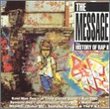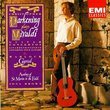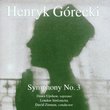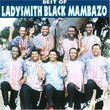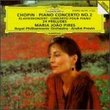| All Artists: Sebastian Bell, Michael Collins, Andrew Crowley, Gareth Hulse, Joan Atherton, Rebecca Hirsch, Timothy Lines Title: Toru Takemitsu: Quotation of Dream (20/21 series) - London Sinfonietta / Oliver Knussen Members Wishing: 3 Total Copies: 0 Label: Deutsche Grammophon Release Date: 2/9/1999 Genre: Classical Styles: Chamber Music, Forms & Genres, Concertos, Historical Periods, Modern, 20th, & 21st Century, Instruments, Keyboard, Symphonies Number of Discs: 1 SwapaCD Credits: 1 UPC: 028945349527 |
Search - Sebastian Bell, Michael Collins, Andrew Crowley :: Toru Takemitsu: Quotation of Dream (20/21 series) - London Sinfonietta / Oliver Knussen
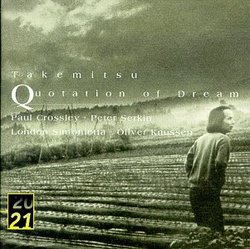 | Sebastian Bell, Michael Collins, Andrew Crowley Toru Takemitsu: Quotation of Dream (20/21 series) - London Sinfonietta / Oliver Knussen Genre: Classical
Sometimes, even while you are listening, it can be very difficult to understand how Takemitsu created such exquisitely beautiful music using so much dissonance. As the brief Day Signal opens the disc, for example, you're m... more » |
Larger Image |
CD DetailsSynopsis
Amazon.com Sometimes, even while you are listening, it can be very difficult to understand how Takemitsu created such exquisitely beautiful music using so much dissonance. As the brief Day Signal opens the disc, for example, you're more likely to think of the glory of sunrise than of the discords. And Quotation of Dream, which quotes freely from Debussy's La Mer, is nearly as beautiful as its source. Rather than waste time figuring out how Takemitsu's spacing of notes and imaginative scoring influences our perceptions, it's much more rewarding just to relax and let the music wash over you. Knussen, who leads amazing performances here, has programmed the disc for a continuous listening experience, although the novice should probably listen only to a couple of pieces at one sitting. --Leslie Gerber Similar CDs
Similarly Requested CDs
|
CD ReviewsSultry, somnolent,decadent - ravishing! Julian Grant | London, Beijing, New York | 09/07/2000 (5 out of 5 stars) "If you are hyper-active and respond only to marching bands then this is emphatically not for you. I'm mystified, having heard this CD half a dozen times why the lush, semi-static sound world common to all of these pieces doesn't cloy, but it doesn't. Not only do they indeed have variety, helped by an amazing ear for orchestral colour and nuance, but the atmosphere engendered is so strong it invites careful listening: one is drawn in to discover ever more subtle changes: textural, thematic, and more rarely, rhythmic. Dissonance is mentioned in the Amazon review; one's perception of dissonance changes here with such a cushioned sound-world, ones ear is tickled by such aural spice, never battered by it. Takemitsu's language, while his own, is deeply eclectic - from the conscious quotes from Debussy's 'La Mer' in 'Quotation of Dream', to extensive echoes of Messiaen, Scriabin and occasionally Ravel. Performances are exemplary and the recording quality classic - the perspectives even cope with the spatially designed ensemble piece 'Archipelago S' with antiphonal ensembles divided by brass and two solo clarinets behind the audience. And I've never heard such beautiful brass pieces in my life , two 'Signals from Heaven' that act as bookends to this compelling anthology. This is powerfully atmospheric, immediate music that will haunt you. Bravos all round." Another world Rick Darby | Tucson, AZ United States | 02/09/2001 (4 out of 5 stars) "Toru Takemitsu was one of the late 20th century's most individual composers whose scores use primarily the traditional instruments of western classical music. Perhaps in part because he wrote film scores in addition to concert pieces, his art is highly communicative and un-academic. It has the double merit of being about as far as you can get both from gnarly, dissonant modernism and from pretty-pretty New Age ear candy.Quotation of Dream includes seven pieces from the last decade of Takemitsu's life (he died in 1996), including the premiere recording of the title piece. The disc begins and ends with fanfares that, while perhaps effective as aural bookends, are to my ears undistinguished. The music that lies in between, however, is extraordinarily compelling.Takemitsu's style in these works is generally meditative, with frequent slow, quiet passages, strings predominating. But there are dramatic incidents and color as well: flaring brass, rising like a mountainous island from a tropical sea; raindrops of chimes; drawn-out woodwind lines weaving sinuously through swirls of massed violins. The music sometimes pivots around silent pauses, like the empty spaces in Zen painting. In Quotation of Dream, twin pianos (played by Paul Crossley and Peter Serkin, respectively) dominate the foreground with gentle cascades of notes while orchestral clouds form in the background.The musical language is often reminiscent of Debussy and Ravel; in mood (though not in technique) it can resemble the slowest and most mysterious moments in music of the second Viennese school (Schoenberg, Berg, Webern et al.). The subtlety and elusiveness probably owe something to the composer's Japanese heritage. But this is no cut-and-paste job; the overall impression is startlingly original. I have not read the liner notes, and have no idea of what Takemitsu is trying to "say," or what these scores "mean." I would also suggest that those considerations are pretty irrelevant: the important thing is the sound world that he has created, which is both other-worldly and bracing.Oliver Knussen, a contemporary British composer and a friend of Takemitsu, conducted the London Sinfonietta in these recordings. It is apparent that that he helped the players, who sound expert, get "inside" the music.Anyone who already knows and appreciates Takemitsu's sensibility need not hesitate to acquire this disc. It can also be recommended for all but the most determinedly "mostly Mozart" classical devotees.The presentation is not ideal. Deutsche Grammophon has never excelled at digital recordings, and the sound of this disc, while detailed and transparent, is a bit bright and clinical. The disc is contained in one of those cardboard containers that some labels are now trying to get you to accept in lieu of the standard jewel case because it's cheaper to produce (but not cheaper for you to buy). The atmospheric sepia-toned photo on the cover has a fat round sticker on it that shouts "World Premiere Recording"; if you try to peel off the sticker, it leaves ineradicable shreds. The plastic tray with the central claw ring is glued to the cardboard. Take care not to break the plastic, because there is no way you can replace it." Takemitsu draws you into his dream world kamus | United States | 04/07/2002 (5 out of 5 stars) "These pieces from Takemitsu's maturity represent the pinnacle of achievement for this gifted composer. Without regard to trends and fashion in contemporary music has has created his own sound universe. A peaceful, yet oddly non-somnolent, serenity informs virtually every bar of these wonderful pieces. The music is beautiful, lush and imaginative at every turn and despite strong ties to the French impressionists it is creative and unique and infused with Takemitsu's personal stamp and his nature-mystical aesthetic. The sound and the performances are first rate and Oliver Knussen must be congratulated on doing such a fine job in bringing these excellent pieces to life. If you love Takemitsu, you will love this CD. If you are new to Takemitsu, this is a wonderful introduction to one of the 20th century's finest composers.
Recommended without reservation." |

 Track Listings (7) - Disc #1
Track Listings (7) - Disc #1